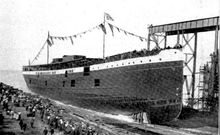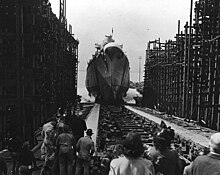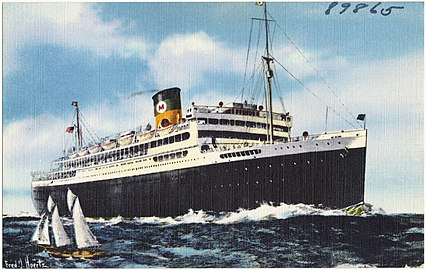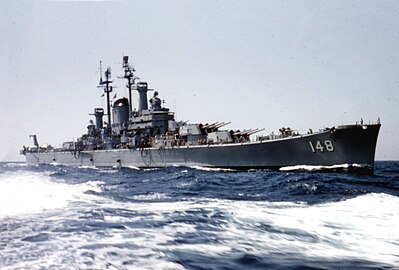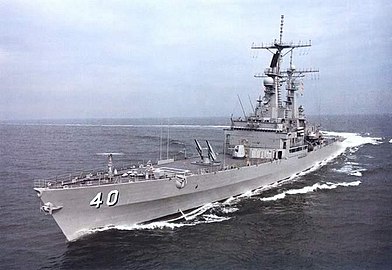
USS John C. Stennis (CVN-74), named for Senator John C. Stennis of Mississippi, is the seventh of the Nimitz-class of nuclear-powered supercarriers in the United States Navy.

USS George H.W. Bush (CVN-77) is the tenth and final Nimitz-class supercarrier of the United States Navy. She is named for the 41st President of the United States and former Director of Central Intelligence George H. W. Bush, who was a naval aviator during World War II. The vessel's callsign is Avenger, after the TBM Avenger aircraft flown by then-Lieutenant George H. W. Bush in World War II. Construction began in 2003 at Northrop Grumman, in Newport News, Virginia and was completed in 2009 at a cost of $6.2 billion. Her home port is Naval Station Norfolk, Virginia.

The Nimitz class is a class of ten nuclear-powered aircraft carriers in service with the United States Navy. The lead ship of the class is named after World War II United States Pacific Fleet commander Fleet Admiral Chester W. Nimitz, who was the last living U.S. Navy officer to hold the rank. With an overall length of 1,092 ft (333 m) and a full-load displacement of over 100,000 long tons (100,000 t), the Nimitz-class ships were the largest warships built and in service until USS Gerald R. Ford entered the fleet in 2017.

USS Dwight D. Eisenhower (CVN-69) is a nuclear-powered aircraft carrier currently in service with the United States Navy. Commissioned in 1977, the ship is the second of ten Nimitz-class aircraft carriers currently in service, and is the first ship named after the 34th President of the United States and General of the Army, Dwight D. Eisenhower. The vessel was initially named simply as USS Eisenhower, much like the lead ship of the class, Nimitz, but the name was changed to its present form on 25 May 1970. The carrier, like all others of her class, was constructed at Newport News Shipbuilding Company in Virginia, with the same design as the lead ship, although the ship has been overhauled twice to bring her up to the standards of those constructed more recently.

USS Enterprise (CVN-65), formerly CVA(N)-65, is a decommissioned United States Navy aircraft carrier. In 1958, she was the first nuclear-powered aircraft carrier and the eighth United States naval vessel to bear the name. Like her predecessor of World War II fame, she is nicknamed "Big E". At 1,123 feet (342 m), she is the longest naval vessel ever built and the only ship of a class that was originally planned to have five other ships. Her 93,284-long-ton (94,781 t) displacement ranks her class as the third largest carrier class, after the Nimitz class and the Gerald R. Ford class. Enterprise had a crew of some 4,600 service members.

USS George Washington (CVN-73) is a United States Navy nuclear-powered aircraft carrier, the sixth carrier in the Nimitz class and the fourth US Navy ship named after George Washington, Founding Father, commander-in-chief of the Continental Army during the American Revolutionary War, and the first president of the United States. The contract for George Washington was awarded to Newport News Shipbuilding on 27 December 1982. Her keel was laid on 25 August 1986, she was christened on 21 July 1990 by First Lady Barbara Bush, and the vessel was commissioned at Naval Station Norfolk on 4 July 1992.

USS Abraham Lincoln (CVN-72) is the fifth Nimitz-class aircraft carrier in the United States Navy. She is the third Navy ship to have been named after the former President Abraham Lincoln. Her home port is NAS North Island, San Diego, California; she is a member of the United States Pacific Fleet. She is administratively responsible to Commander, Naval Air Forces Pacific, and operationally serves as the flagship of Carrier Strike Group 3 and host to Carrier Air Wing Nine. She was returned to the fleet on 12 May 2017, marking the successful completion of her Refueling and complex overhaul (RCOH) carried out at Newport News Shipyard. On 1 April 2019, USS Abraham Lincoln was deployed to the Middle East as the flagship for Carrier Strike Group 12 and Carrier Air Wing Seven assigned to her.

USS Theodore Roosevelt (CVN-71) is the fourth Nimitz-class, nuclear-powered, aircraft carrier in the United States Navy. She is named in honor of Theodore Roosevelt, the 26th President of the United States and a proponent of naval power. She is the fourth ship named in honor of Theodore Roosevelt, three bearing his full name and a fourth with just his last name. Another three U.S. Navy ships have "Roosevelt" in their names in honor of members of the Roosevelt family. This carrier's radio call sign is "Rough Rider", the nickname of President Roosevelt's volunteer cavalry unit during the Spanish–American War. She was launched in 1984, and saw her first action during the Gulf War in 1991.

The Gerald R. Ford-class nuclear-powered aircraft carriers are currently being constructed for the United States Navy, which intends to eventually acquire ten of these ships in order to replace current carriers on a one-for-one basis, starting with the lead ship of her class, Gerald R. Ford (CVN-78), replacing Enterprise (CVN-65), and later the Nimitz-class carriers. The new vessels have a hull similar to the Nimitz class, but they carry technologies since developed with the CVN(X)/CVN-21 program, such as the Electromagnetic Aircraft Launch System (EMALS), as well as other design features intended to improve efficiency and reduce operating costs, including sailing with smaller crews. This class of aircraft carriers is named after former U.S. President Gerald R. Ford. CVN-78 was procured in 2008 and commissioned into service on 22 July 2017. The second ship of the class, John F. Kennedy (CVN-79), is scheduled to enter service in 2025.
Avondale Shipyard was an independent shipbuilding company, acquired by Litton Industries, in turn acquired by Northrop Grumman Corporation. In 2011, along with the former Ingalls Shipbuilding, the yard was part of Huntington Ingalls Industries. It closed in October 2014. The yard was located on the west bank of the Mississippi River in an area called Bridge City, about 20 miles (32 km) upriver from New Orleans near Westwego, Louisiana. It was the site of the modernization of the battleship USS Iowa in the early 1980s and also constructed some of the lighter aboard ships (LASH). At one time, it was the largest employer in Louisiana, with about 26,000 employees.

USS Gerald R. Ford (CVN-78) is an aircraft carrier for the United States Navy and the lead ship of her class. The ship is named after the 38th President of the United States, Gerald Ford, whose World War II naval service included combat duty aboard the light aircraft carrier Monterey in the Pacific Theater.
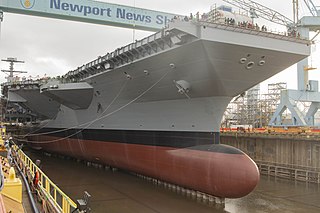
USS John F. Kennedy (CVN-79) is the second Gerald R. Ford-class aircraft carrier built for the United States Navy. She was launched on 29 October 2019, and christened on 7 December 2019.

USS California (SSN-781), is the eighth Virginia-class submarine, and the seventh United States Navy ship named for the state of California. The contract to build her was awarded to Newport News Shipbuilding in Newport News, Virginia, on 14 August 2003. Construction began in December 2006. California's keel was laid down on 1 May 2009. She was christened on 6 November 2010, sponsored by Donna Willard, wife of Admiral Robert F. Willard. She was launched eight days later, on 14 November 2010.
In the United States Navy, Refueling and Overhaul (ROH) refers to a lengthy refitting process or procedure performed on nuclear-powered naval ships, which involves replacement of expended nuclear fuel with new fuel and a general maintenance fix-up, renovation, and often modernization of the entire ship. In theory, such process could simply involve only refueling or only an overhaul, but in practice, nuclear refueling is always combined with an overhaul. An ROH usually takes one to two years for submarines and up to almost three years for an aircraft carrier, performed at a naval shipyard. Time periods between ROHs on a ship have varied historically from about 5–20 years (for submarines) to up to 25 years (for Nimitz-class aircraft carriers). For modern submarines and aircraft carriers, ROHs are typically carried out about midway through their operating lifespan. There are also shorter maintenance fix-ups called availabilities for ships periodically at shipyards. A particularly lengthy refueling, maintenance, and modernization process for a nuclear aircraft carrier can last up to almost three years and be referred to as a Refueling and Complex Overhaul (RCOH).

Huntington Ingalls Industries, Inc. (HII) is the largest military shipbuilding company in the United States as well as a provider of professional services to partners in government and industry. HII, ranked No. 375 on the Fortune 500, was formed on 31 March 2011, as a divestiture from Northrop Grumman.

USS Enterprise (CVN-80) will be the third Gerald R. Ford-class aircraft carrier to be built for the United States Navy. She will be the ninth United States naval vessel and third aircraft carrier to bear the name, and is scheduled to be in operation by 2028. Her construction began in August 2017 with a steel-cutting ceremony.

Vice Admiral Thomas J. Moore was a senior officer in the United States Navy. He retired from active duty on June 19, 2020, after 39 years of service. He currently serves as Vice President of Nuclear Operations at Huntington Ingalls Industries.

USS Doris Miller (CVN-81) will be the fourth Gerald R. Ford-class aircraft carrier of the United States Navy. Doris Miller is scheduled to be laid down January 2026, launched October 2029 and commissioned in 2032. She will be built at Newport News Shipbuilding, a division of Huntington Ingalls Industries in Newport News, Virginia.


